With the arrival of warm days, it is urgent to take measures to safely wear minis and sandals. But you can take care of the beauty and comfort of your foot skin in advance.
- Causes of dry skin on feet
- How to properly care for dry skin on your feet
- How to get rid of dry shins
- How to get rid of dry feet
- Precautionary measures
- Salon foot treatments
- Proper nutrition
- Cosmetics for foot care
- Tools Overview
Causes of dry skin on feet
Not long ago, American beauty bloggers created a buzz around foot care on the Internet by recording a million videos about daily foot care. According to them, this is what it should include.
Hydration is important throughout the year, but the issue is especially acute in the summer. Cracked skin on the heels looks unaesthetic, and in general it is an unhealthy phenomenon.
Pedicure: well-groomed nails, moisturized cuticles, bright varnish - not just “for beauty”, but as part of personal hygiene.
Fighting excessive sweating. If you are concerned about this problem, drying creams and talc should become your daily companions.
If you have hyperhidrosis, it is better to consult a specialist: now there are many ways to combat it, including Botox injections.
Baths: according to bloggers, this is the easiest and most affordable way to quickly get your feet in order, relieve fatigue, and prepare your skin for further care.
It’s a pity that the maximum blogger program did not include the problem of dry skin. We will correct their omission. The reasons for this phenomenon can be very different.
- Structural features. There are few sebaceous glands on the ankles, feet and legs, so the skin here is more likely to become dry and rough.
- Wrong cosmetics and illiterate care. Even worse can only be its complete absence.
- Presence of diseases. This includes not only dermatitis, but also venous insufficiency, which is associated with impaired blood supply to the skin.
- Lack of vitamins.
- Fungal diseases. In this case, large-plate peeling appears in the area of the feet, and changes in the skin in the spaces between the toes. In this case, only a complete treatment regimen under the supervision of a dermatologist is indicated.
Spring will come - and you will urgently need to do something urgently with the skin of your feet, which is so dry and flaky. © iStock
How to properly care for dry skin on your feet
Smooth and soft skin on your legs is the same indicator of self-love as a well-groomed face and healthy hair. Particular attention will have to be paid to the feet, because this is one of the driest and most problematic areas on the body. It is better to take care of your feet in several stages.
Daily cleansing
It is important not only to wash your feet well, but also to wipe them dry - this way you will not disturb the skin microflora. If you have severe dryness, you can exfoliate once a week.
Combine a scrub with crushed apricot kernels with a herbal or salt bath and subsequent application of a mask.
Hydration and nutrition
To keep your heels smooth, after washing, apply a moisturizing (in summer) or nourishing (in the cold season) cream to your feet. The same goes for skin care on the legs and thighs - this area is also prone to dryness and flaking, so daily moisturizing and nutrition will come in handy.
Foot massage
While applying foot cream, give a light massage to your feet and legs. This will help activate blood circulation and ensure access of oxygen to skin cells. Well, in general, massage is an excellent procedure against fatigue and for tone.
Apply foot cream using upward movements, moving from your feet to your knees and thighs.
How to get rid of dry shins
Dry skin on the legs often occurs due to lack of sufficient hydration, especially after depilation. Make it a rule to regularly treat your skin with a moisturizing or nourishing body cream, and after removing hair, do not forget to apply cosmetic oil.
How to get rid of dry feet
To keep your feet in perfect condition after water treatments, as well as visiting the pool and shower at the fitness club, apply cream. If you don’t have a special foot product on hand, any cream with a moisturizing effect will do.
Precautionary measures
The main rule when caring for your feet is this: act without fanaticism. What do we mean? Of course, treatment of the heels - the most problematic area on the legs.
- You should not use an abrasive file or pumice more than once every two weeks. Otherwise, the skin's protective barrier will be damaged.
- Treat heels only in areas of severe roughness and only after steaming.
- The movements should not be too strong - otherwise you will get microtraumas.
Scrub and exfoliating agents are used during water procedures. © iStock
Salon foot treatments
Do you want a professional to take care of your feet? Go to a beauty salon, nail bar or clinic where a podologist, a specialist in medical pedicure, sees you.
Pedicure
This pleasant and useful procedure lasts about 1.5–2 hours and consists of several stages:
- disinfectant steam bath;
- cuticle and nail treatment;
- skin exfoliation - hardware, mechanical, using acid peeling;
- applying a mask;
- applying varnish;
- applying cream or balm, massage the legs and feet.
Paraffin baths
This procedure is recommended for dry, rough skin of the feet to soften and moisturize. Clean, treated feet are dipped into a special paraffin solution heated to a certain temperature (you should be comfortable).
There are few sebaceous glands on the ankles, feet and legs, so the skin here is more likely to become dry and rough. © iStock
Proper nutrition
If dry feet is not a seasonal phenomenon, but a permanent one, pay attention to your diet. One of the reasons for skin discomfort is a deficiency of vitamin A, which is responsible for smoothness and elasticity, as well as vitamin E, which promotes softness.
The diet for smooth skin on your feet looks like this:
- seafood and fish;
- cereals in the form of bread and cereals;
- olive or any other vegetable oil;
- fruits and vegetables.
Don't forget to drink enough - this is especially important if you have dry skin. The norm for a healthy person is 1.5–2 liters of pure still water per day.
If severe peeling occurs, do not delay visiting a dermatologist.
Cosmetics for foot care
- Foot cream Suitable for daily use. Apply it immediately after a shower, for more intense hydration - at night in a thick layer, put on cotton socks on top.
- Foot gel with a cooling effect, it will work well in the summer and after a long walk. By moisturizing the skin, it also relieves fatigue and puffiness.
- Balm with a dense texture, suitable for very dry skin on the feet and knees. Replenish lipid levels.
- Scrub and exfoliating agents are used during water procedures. After peeling, the skin of the feet better accepts subsequent care.
Make it a rule to regularly treat your skin with a moisturizing or nourishing body cream. © iStock
Dry skin on the legs can develop for a number of reasons, both external and internal. At the same time, peeling, itching, and cracks in the skin occur. Special foot baths, medicated creams and oils, vitamin complexes and diet optimization will help get rid of this problem.
Main external reasons
External causes of dry skin include:
- wearing synthetic items (socks, tights, stockings);
- constrictive clothing and shoes;
- oversaturation with sunlight;
- use of cosmetics with a high content of alkalis;
- influence of external aggressive environment (chlorine in the pool, ecology)
Clothing made from synthetic materials can irritate the skin of your feet. The heat exchange process of the skin may be disrupted. Another negative property of synthetics is static electricity. The harm it causes is based on a neuroreflex mechanism. Electricity directly irritates the weakly protected nerve endings of the dermis.
Tight clothing and shoes have a detrimental effect on blood circulation, disrupt the movement of lymph and blood in the tissues, which causes dry skin. If clothing is tight, it interferes with the normal ventilation of the skin, which leads to discomfort, burning, itching and redness. The skin is poorly moisturized and dries.
The skin dries and ages when exposed to sunlight. They negatively affect elastin and collagen fibers. Under the influence of ultraviolet radiation, biochemical processes occur in the skin that cause its degeneration. These processes are called photoaging.
Cosmetics with a high alkaline content weaken the pH value of the skin. Trying to restore it, the dermis secretes skin lubricant, which causes moisture to decrease. This destroys the barrier that holds water.
Alkaline cosmetics accelerate transdermal moisture loss. The consequence of this is premature aging. Plus, under the influence of alkali, the dermis is more susceptible to photoaging.
External causes of dry skin include high chlorine content in the pool. It leads to irritation, peeling, and a feeling of tightness. In addition, dry skin can be affected by hard water, which disrupts sebum production.
Another negative external factor is gas pollution in cities. Exhaust gases, penetrating into skin cells, destroy the epidermis, elastin and collagen fibers, activate free radicals, which leads to a decrease in skin elasticity and dryness.
Main internal reasons
The skin of the feet dries out for the following internal reasons:
- diseases;
- problems with blood supply;
- lack of minerals and vitamins;
- age-related changes.
Dryness can be a sign of psoriasis, eczema, diabetes, and fungal infections.
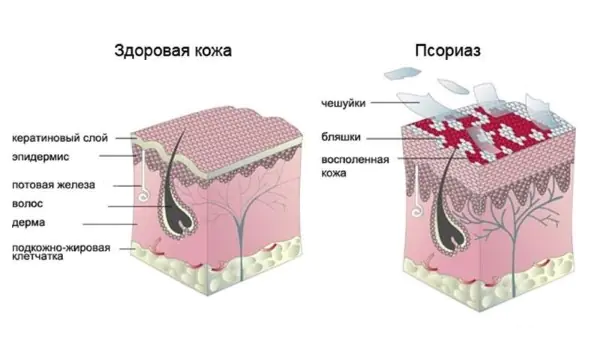
Failures in the blood supply lead to a lack of oxygen, nutrients, and fluid in the tissues. Without receiving these components in the required quantity, the skin dries out.
The reasons for this phenomenon may be related to a lack of vitamins. The main vitamins for combating dry skin are:
- retinol (vitamin A);
- tocopherol (vitamin E);
- B vitamins;
- ascorbic acid (vitamin C);
- biotin (vitamin H).
They moisturize the skin and form new cells. Age-related dry skin is associated with hormonal changes in the body. New cells form more slowly, and old ones do not have time to transform.
Dryness and flaking
The skin on the legs becomes dry and flaky for the following reasons:
- Allergy. An allergen can be a food product, clothing material, dust, or pet hair. If possible, avoid irritants and take antihistamines.
- Stress, overwork lead to the release of cortisol. It changes collagen molecules, which leads to dry and flaky skin.
- External aggressive environment (chlorine in the pool, ecology, ultraviolet radiation).
- Age-related, hormonal imbalances The body appears after 50 years of age, which causes dry skin. This happens due to changes in the structure of collagen fibers, which primarily form the epidermis. It is recommended to eat more foods containing collagen and drink clean water to support fat and lipid metabolism.
- fungal infections, which lead to skin irritation and changes in its structure.
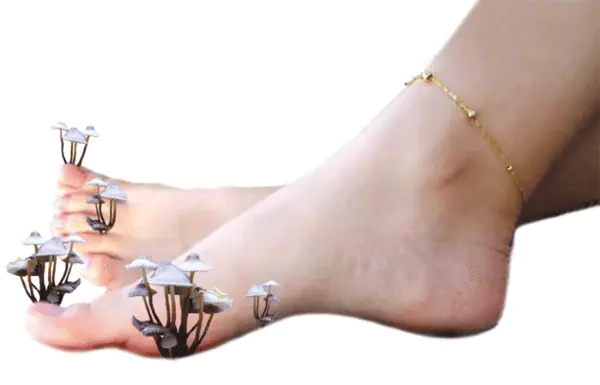
In older people, all causes become more acute.
Dry and itchy feet
Dry and itchy skin on the legs can occur due to a number of diseases: rubella, chicken pox, measles.
Causes of itching:
- Itchy feet can be caused by allergies, such as hives. Another cause of itchy skin on the legs is excess glucose levels in diabetes mellitus.
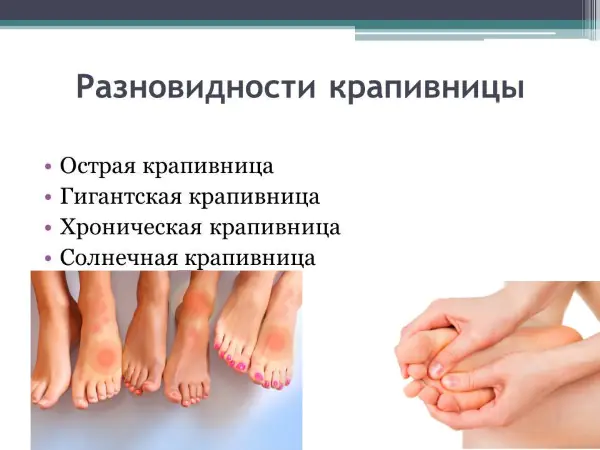
- With liver diseases, itching of the lower extremities appears. This occurs due to the release of bile into the blood, which affects the nerve endings.
- Impaired blood supply is the cause of itching, accompanied by swelling and heaviness. Acute itching that occurs on the foot and between the toes may be due to a fungal infection.
Dry skin of the lower leg
The lower leg is very sensitive to changes, since this area has 9 times fewer sebaceous glands than other parts of the skin. Dryness of the lower leg occurs for reasons such as dry air, synthetic clothing, temperature changes and poor-quality depilation of this area. Excessive use of solariums can also lead to dry skin.
Dry skin on feet
Dry skin on the feet is often caused by walking without shoes in the summer. This may be accompanied by the appearance of a fungal infection. One of the main reasons is uncomfortable shoes made from non-natural materials, so the skin does not breathe.
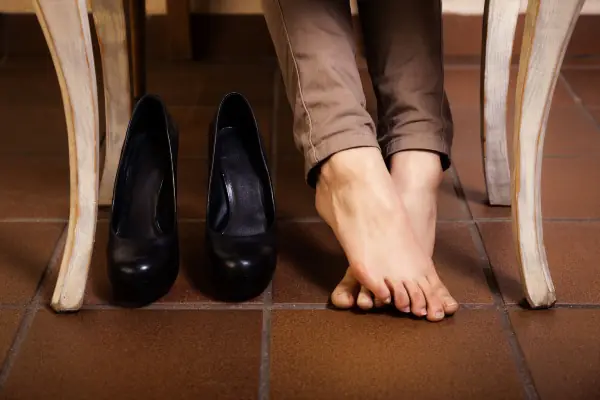
Dry skin on the legs. The reasons may be the appearance of a fungus. It occurs when wearing uncomfortable shoes that do not breathe. It is important to choose quality shoes
This is aggravated by the special skin of the sole, which is thicker than in other areas. Inflammation and cracks can result from insufficient care of the skin of the feet.
Dry skin on knees
The skin on your knees may dry out for these reasons:
- Lack of vitamins A and E.
- Kneeling poses.
- The influence of clothing.
- Hormonal problems.
- Lack of vegetable fats.
In addition, dry skin on the knees is a natural reaction of the body to the constant flexion and extension of this joint.
Causes of cracks
The appearance of cracks in the skin of the lower extremities is influenced by:
- Summer footwear. When wearing slates, the sole of the foot may receive impacts and microtraumas. Dry air and hot sand can also have a detrimental effect.
- Uncomfortable shoes and synthetic socks. When using them, the soles of the feet dry out and become cracked.
- Insufficient foot care. You should use baths and remove keratinized epidermis.
- Fungal infections. They are eliminated with antifungal drugs. Shoes should be disinfected.
- Kidney diseases and endocrine disorders.
- Disorders and diseases of the gastrointestinal tract.

To completely cure cracks, it is necessary to find out the cause and take preventive measures.
Dry spots on the skin of the legs
Dry spots on the skin of the legs are formed due to a disruption in the functioning of the sebaceous and fatty glands.
This is influenced by factors:
- Allergies to food, medications and other substances (detergents and cosmetics).
- Diseases of the gastrointestinal tract.
- Fungus and similar diseases (various types of lichen).
- Skin disease such as eczema, psoriasis and others.
- Stressful state.
Dry spots also appear due to fluid deficiency and liver dysfunction.
Signs of the disease
Along with dry skin on your feet, other symptoms may appear:
- Separation of a layer of skin due to fungal infections.
- Dermis flows between the fingers.
- Bubbles appear, burst and dry out.
- Acute peeling.
- Psoriatic arthritis.
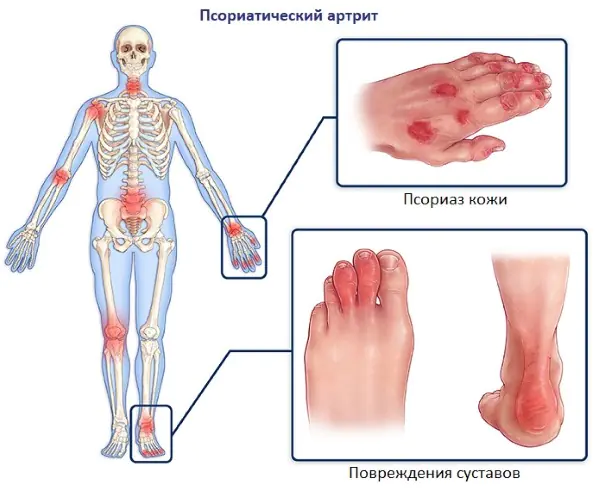
- A papular rash occurs between remissions.
- There is an irregular structure of the nails.
- Change in color of the dermis.
- Hard nodules form.
The listed symptoms relate to diseases: psoriasis, eczema, mycosis.
Cosmetics for the skin of the feet
Cream "Zorka"
It includes: chamomile extract; vitamins A, E; glycerol. The cream neutralizes inflammation, bacteria, moisturizes and nourishes the skin.
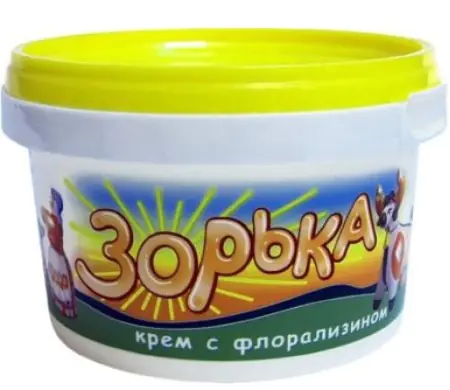
Apply at night on clean feet. It is advisable to wear cotton socks. Frequency of use: 1 time every 3 days.
Cream “Forest Power”
Compound: sorbic acid, flavorings, petroleum jelly, floralisin. The cream delivers oxygen to the cells of the dermis, nourishes it, and restores collagen tissue. The product is rubbed into the skin of the feet using massage movements. The procedure is repeated 2 times a day.
Cream “Lekar” with urea
Contains: urea, celandine extract, allantoin, oak bark extract, vitamin E, tea tree essential oil.
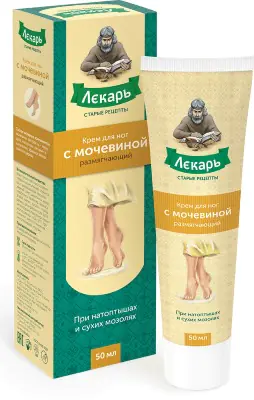
The drug softens the dermis of the heels and feet, and eliminates dried calluses. Rub onto clean, dry skin before bed once a day.
Cream "Sesderma"
Compound: oat extract, urea. It has a moisturizing, cleansing, soothing effect on the skin and eliminates itching. The cream should be rubbed in morning and evening, massaging problem areas until completely absorbed.
Therapeutic foot baths
Sea salt bath
Ingredients: warm water, one and a half tablespoons of salt. Dissolve the salt and place your feet in the water for 15 minutes. Then wash off the salt with water and moisturize the skin with cream. It is not recommended to continue the procedure longer, as salt corrodes the dermis.
Red wine bath
Ingredients: water (2 l), red wine (500 ml). After mixing, keep your feet there for 20 minutes. Wipe your feet and apply cream. The bath can be taken once a week.
Bath with medicinal herbs
Ingredients: wormwood, chamomile, mint, calendula, lemon balm. Pour hot water over the herbs and leave for 30 minutes. Keep your legs in the pelvis for no more than 20 minutes. After wiping them, moisten them with cream.
Baking soda and soap bath
Ingredients: baking soda (14 gr.), 15 gr. soap shavings. Stir in water at room temperature. The procedure lasts no more than 15 minutes.
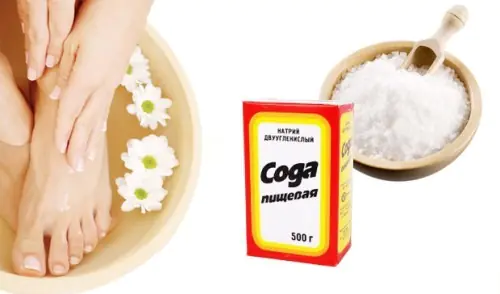
Upon completion, the feet are rinsed with clean water and moisturized with cream.
Streamlining your diet for healthy skin
To maintain healthy skin, the following foods should be present in your diet:
- Fruits and vegetables are orange in color. For example: persimmons, carrots, peaches, pumpkin, apricots. They contain vitamin A, which is necessary for skin cell renewal.
- Citrus fruits containing vitamin C. It promotes collagen formation for proper skin pigmentation and is a strong antioxidant.
- Lettuce and spinach. Vegetables are beneficial for the skin because they contain vitamins A, C, B, E.
- Nuts. They are rich in B vitamins and useful elements such as potassium, cobalt, iron, magnesium, phosphorus, manganese. Thanks to them, fats and proteins are more efficiently synthesized in cells, and new dermal tissues are formed.
- Cereals. They contain B vitamins, proteins, zinc, silicon, selenium, cobalt, copper, potassium. Dietary fiber improves the functioning of the digestive system and removes waste and toxins from the body. Silicon increases turgor and elasticity of the dermis.
- Dairy products enhance intestinal motility and normalize its microflora.
- Iron-rich foods. Apples, pomegranates, blueberries, white beans, liver, red meats, seafood. Iron increases hemoglobin, which supplies oxygen to tissues, preventing the effects of toxins and skin aging.
- Omega fatty acids found in fatty fish, vegetable oils, flax seeds, cod liver, and nuts. Restore the lipid layer that protects skin cells. Saturates the skin with moisture, making it elastic.
- Green tea, being a natural antioxidant, prevents skin aging.

Poor nutrition and fluid deficiency lead to depletion and dryness of the epidermis. Every adult needs to drink at least 2 liters. water per day.
Vitamin complexes
- "Perfectil". Ingredients: almost all vitamins, copper, biotin, selenium, zinc. The drug counteracts skin aging. Take 1 capsule after meals per day for a month. Between courses there are intervals of 1-2 months.
- "Vitrum Beauty". Ingredients: vitamins A, D, E, C, B, folic acid, nicotinamide, rutin. Microelements: iodine, iron, manganese, calcium, selenium, boron, zinc, magnesium. The drug restores and strengthens the structure of the dermis. The complex is taken 2 tablets per day after meals. It is possible to increase the dose to 3 tablets.
- "Supradin". Ingredients: vitamin A, D, E, PP, H, sodium bicarbonate, sucrose, sodium saccharin, mannitol, lemon flavor, tartaric acid. “Supradin” improves the efficiency of metabolic processes and promotes the synthesis of the collagen layer of the skin. The drug is taken 1 tablet with meals 1 time per day. The course lasts 30 days, after which there is a break for a period of 60 to 90 days.
Recipes for medicinal compositions for skin
Moisturizing peeling mask
You will need oatmeal (3-4 tablespoons), sugar, honey, 2 tablespoons of cosmetic oil. spoons. The flakes are ground in a coffee grinder. The remaining components are added and mixed to a dense mass.

Rub the product onto pre-steamed feet using massaging movements and leave on for several minutes. Rinse the mixture with water and apply cream. You can make a mask every day.
Nourishing softening mask
Ingredients: honey, sour cream, full-fat cottage cheese. 2 tbsp. tablespoons of cottage cheese are mixed with sour cream and honey (1 tablespoon each). Rub the mixture into the skin of your feet and leave for 40 minutes. Rinse and moisturize the skin with cream. Repeat the procedure 2-3 times a week.
Mask for exfoliating old cells
Compound: oat flour, chopped nuts, sour cream. Flour (3 tablespoons) is thoroughly mixed with nuts (1 tablespoon), sour cream is added, everything is mixed until smooth. Apply to feet and leave for 20 minutes. After this, rinse your feet with clean water, rub your feet with a file and apply cream.
Nourishing oils and how to use them
- Shea butter (another name is “shi”) moisturizes the epithelium, softens and soothes the skin. Forms a protective layer of the dermis. Should be used before bed: rub in the oil and put on socks.
- Olive oil has a moisturizing effect due to the content of fatty acids. Oleic acid promotes hydration and restores the outer layer of the epidermis. The oil is rubbed into the skin and lasts for 1 hour. Be sure to rinse with warm water, as cold water increases dryness of the skin.
- Coconut oil contains such acids as lauric, hyaluronic, more than 7 types of fatty acids, and their triglycerides. They moisturize the epithelium, heal cracks, destroy bacteria, preventing fungal diseases. Before going to bed, the oil is rubbed into the skin, after which it is treated with pumice. It is advisable to wear socks.
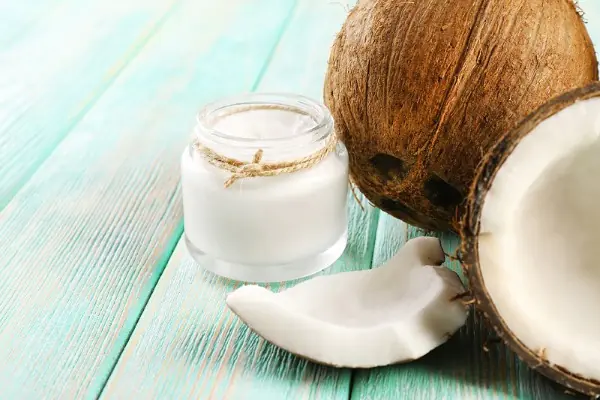
Dry skin on the legs, the causes of which are varied, can be eliminated on your own. Vitamin preparations, recipes for moisturizing and nourishing baths, and the use of oils will help with this. It is also important to remember that excessive dryness with other symptoms can be a sign of a developing disease.
Video about dry skin on feet
Causes of dry feet:
Traditional methods of treatment:
A woman should be well-groomed from head to toe. Many people make a big mistake by focusing only on their facial skin. Meanwhile, beautiful, smooth and tanned skin on such a part of the body as the legs makes its owner an object of universal admiration. Often, due to an insufficient level of moisture, including lack of care, the skin becomes dry and often flakes. Regular hair removal procedures worsen the situation. Lack of moisture reduces the elasticity of the skin and makes it defenseless against the negative effects of environmental factors.
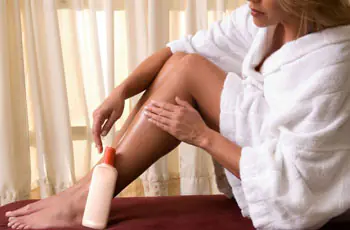
Causes of dry skin on feet.
If dry skin appears on the legs, one should talk about either an insufficient level of lipids or moisture in the stratum corneum, or a slow process of replacing old epithelial cells with new ones. Against this background, the protective functions of the skin are disrupted, resulting in dryness. The causes of dry feet can be different. These include:
- Clothes made from non-natural fabrics. Synthetic clothing (tights, leggings) often become a source of skin irritation, which manifests itself, among other things, in the form of dryness and flaking.
- Cosmetics. Incorrectly selected cosmetics or those that are not suitable for a particular person dry out the skin. When choosing skin care products for the body (including legs), be sure to pay attention to the composition; they must include natural oils or ceramides.
- Insufficient care or lack thereof. Not many women care for the skin of their legs as carefully as they do their facial skin. Meanwhile, this part of the body requires the same careful care. Be sure to use a body (foot) scrub once a week to remove dead skin particles and prevent flaking.
- Presence of diseases. Very often, dry skin is one of the symptomatic manifestations of a disease. This could be psoriasis, eczema, diabetes. In addition, dryness may be a consequence of a lack of vitamins in the body and the presence of fungal infections.
- Age. Dry skin is a consequence of age-related changes. Over the years (after forty years), the skin becomes drier, which requires more careful and regular care. It is also important to drink clean water (mostly women replace the daily fluid intake with juice, tea and coffee, forgetting about plain water, which is fundamentally wrong), include more fruits and vegetables, fish in the diet, and take vitamin complexes. During this period, it is also important to abandon hygiene products containing alkali (as is known, it dries the skin very much).
- Impaired blood circulation. Dry skin is also a symptom of problems in the cardiovascular system, namely in pumping blood through the blood vessels. At the same time, the sweat and sebaceous glands do not cope with their function, as a result, the skin loses its natural lubrication, becoming dry. In this case, it is recommended to carry out hardening activities, do exercises, play sports, in general, strengthen and train blood vessels. If your professional activity involves staying in one position for a long time (working at a computer) or standing on your feet for a long time (teachers, hairdressers, etc.), you need to periodically take breaks (walk, stand up) so as not to disturb blood flow.
Proper hydration of the skin on the legs.
It is necessary to apply any cosmetics to the skin of the feet (and not only) when the pores are open. This can be achieved by taking a bath, shower, or foot bath (if you have dry heel skin). If you apply the cream without such a preliminary “steaming” procedure, the skin will not be able to absorb to the maximum all the nutritional components included in its composition. Never use soap; it dries out the skin and removes its protective natural oils. When taking a shower, avoid perfumed gels, just expose your body to a good stream of warm water. This water massage is an excellent way to improve vascular tone. After the procedure, apply a fat-based cosmetic or natural oil (linseed, olive, almond) to still damp skin, wait a couple of minutes to absorb, then remove excess with a paper napkin.
To prevent dry skin on your heels and cracking, it is important to regularly remove the stratum corneum using a pumice stone. Just be sure to do this on dry heels, and never steam them, otherwise you can only worsen the situation. After the procedure, you should definitely moisturize the skin of your heels, for which it is ideal to use a special cream containing urea, as well as make masks. It's good to make homemade masks.
Combating dry skin on your feet.
To properly and sufficiently provide the skin with moisture and nutrients, it is important to choose a set of procedures for caring for very dry skin of the feet. For this purpose, it is not at all necessary to spend fabulous sums; you can make do with available funds (only when choosing, be sure to look at the composition). Systematic care will restore lost smoothness and elasticity to the skin.
If dry skin is a constant phenomenon, then first of all you need to pay attention to your diet, enriching it with seafood, vegetable oils, cereals, fruits and vegetables, vitamins A (for smoothness and elasticity), E (eliminates itching). In autumn and closer to spring, courses of taking multivitamin complexes (monthly) are recommended. Drinking regime is also important (at least a liter per day).
If the cause of dryness is a disease (which one will be determined by the doctor), it is necessary to eliminate it. In this case, it is useless to eliminate dry skin, since it is just a symptom and not the disease itself.
Preference should be given only to clothes made from natural materials.
Additional home treatments to eliminate dry skin on your feet.
Paraffin therapy for feet.
The paraffin therapy procedure can be carried out in a beauty salon, but it is quite acceptable to do it at home. To do this, you need to buy cosmetic wax, melt it and apply a thin layer to your feet. After hardening, apply a couple more layers. Wrap the top with plastic wrap and a thick towel for extra warming. After thirty minutes, remove the wax film and remove the rough skin with a pumice stone. The procedure helps to further soften and moisturize the skin.
Foot baths.
Foot baths based on chamomile and hops, sage and oak bark, bran and oats (in the same ratio, two tablespoons per liter of boiling water, leave for twenty to thirty minutes) are useful. Such baths should be done regularly twice a week for fifteen minutes, after which a cream with a moisturizing or nourishing effect should be applied to the skin.
How to get rid of dry shins?
Dry skin in this area is the result of improper depilation. In this case, after shaving, you need to use special products or vegetable oil. The problem will quickly disappear.
Foot masks.
The simplest and most accessible is to rub vitamin A and E or coconut oil, cream (sour cream) into the skin of your legs (feet). It's better to do this at night. Remove excess with a paper napkin.
You can add a few drops of essential oil to your regular foot cream (it is ideal to use patchouli, sandalwood or tea tree oil for your feet).
If the skin of the feet is too dry, such procedures should be done daily; after its condition improves, it can be done twice a week as a preventative measure.
Or here is a recipe for a mask for dry feet: cut apples into slices, boil them in milk until mushy. Apply the mixture while warm to the skin of your feet, wrap it in gauze and leave for half an hour. Next, you don’t need to wash off the mask, but simply wipe it with a cotton cloth after removing the slurry. After the procedure, put on socks.
The mask prevents heels from cracking.
To soften the skin of your feet, the following mask is suitable: grind a teaspoon of butter with a raw egg yolk, add two teaspoons of raw potato pulp (grated on a fine grater) and four teaspoons of baby cream. Apply the mixture to your feet, wrap them in food grade polyethylene and put on warm socks. After twenty minutes, wash everything off. The procedure perfectly softens the skin of the heels. Carry out twice a week.
Prevention of dry skin on the legs.
- Use a humidifier in your apartment, office, or room where you work.
- Do not use soap.
- Regularly cleanse and moisturize the skin of your legs and feet.
- Change your diet, enriching it with vitamins and beneficial microelements.
By following these simple rules, you will maintain or restore your legs to their former attractiveness.



